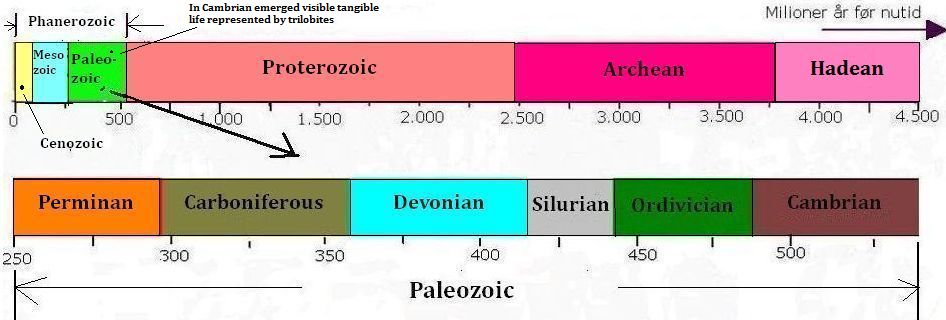
|
Home DH-Debate 1. Precambrian 3. Mesozoic |
| 1. Introduction | 2. Cambrian |
| 3. Ordovician | 4. Silurian |
| 5. Devonian | 6. Carboniferous |
| 7. Permian | 8. Literature |
Phanerozoic denotes the part of the Earth's history, where life has been.
Paleozoic is the longest of the Phanerozoic eras. It was the period of early life where plants, corals, mollusks, insects, fish, and many other living organisms emerged. Paleozoic is divided into six geological periods, which are the Cambrian, Ordovician, Silurian, Devonian, Carboniferous and Permian.
It is common to call the widespread explosion of life for the Cambrian explosion. The Cambrian climate is assumed to have been temperate. The Ordovician and Silurian periods had a warm greenhouse climate only interrupted by the Andean-Saharan Ice Age. Devonian and Carboniferous were periods of considerable stability until the Karoo Ice Age at the end of Carboniferous. In Permian dominated a harsh and dry continental climate on the enormous Pangea continent.

|
Hadean was the glowing inferno just after Earth was formed. In Archean the first rocks, which we know about, were formed, water vapor condensed and an atmosphere of nitrogen and methane came into being. In Proterozoic cyanobacteria produced oxygen that oxidized iron and methane. Also in Proterozoic occurred several very severe Ice Ages that is the Huronian, Sturtian, Marinoan and Gaskiers ice ages. At the end of the period, life emerged on the seabed.
However, the early geologists, who defined and named the geological periods, knew nothing of fossilized bacteria from Archean or the exotic Ediacaran fauna in the late Proterozoic. They had found the fossilized trilobites from the Cambrian, and therefore they believed that it was during that time life emerged on Earth, and therefore it should be marked by the start of a special geological era, which was characterized by life namely Phanerozoic.
Phanerozoic has been divided into Paleozoic, Mesozoic and Cenozoic that we can call Earth's antiquity, medieval and modern times. Paleozoic was the era of early life and is the subject of this article. Mesozoic was the era of the dinosaurs; and Cenozoic is the age of mammals.
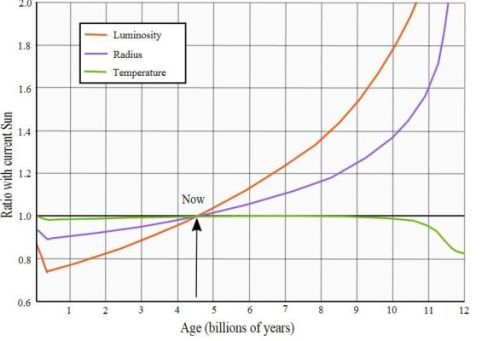
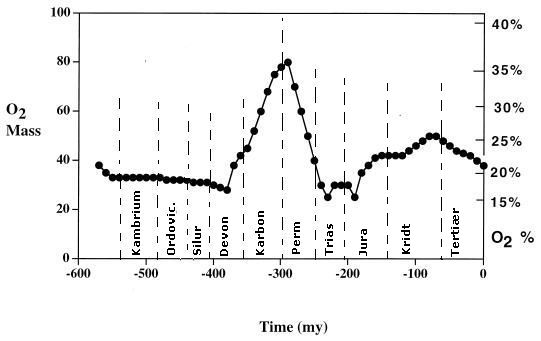
|
Top: Sun's luminosity, radius and temperature, as a function of its age in
Billions of years - after Ignasi Ribas: "The Sun and stars as the primary energy input in planetary atmospheres" - Proceedings of the International Astronomical Union, IAU Symposium.
Below: Variations in atmospheric oxygen content through Phanerozoic by Robert Burner Yale University - added the geological periods. It seems like at the end of Proterozoic there has been a significant oxygen content in the atmosphere.
The sun is a star in the Hertzsprung-Russell diagram's main sequence. It will remain in the main sequence about 11 billion years, during that time it will increase its brightness three times in total. Start of Paleozoic happened about 500 million years ago and the sun had then a brightness of more than 95% of its present. By the end of Paleozoic, the Sun's brightness had risen to nearly 97% of today's.
According to Robert Berner of Yale University, the oxygen content of the atmosphere has fluctuated between 15 and 35% over Phanerozoic.
Oxygen percentage reached its peak in late Carboniferous and early Permian and then declined dramatically to 15% at the transition from the Permian to Triassic. It is believed that the high value in Late Carboniferous was due to that the produced oxygen was not used to oxidize organic material, which instead was buried in bogs and other marshy areas. The subsequent decrease in the oxygen content of the atmosphere may have been caused by a cool climate, that was not very good for photosynthesis.
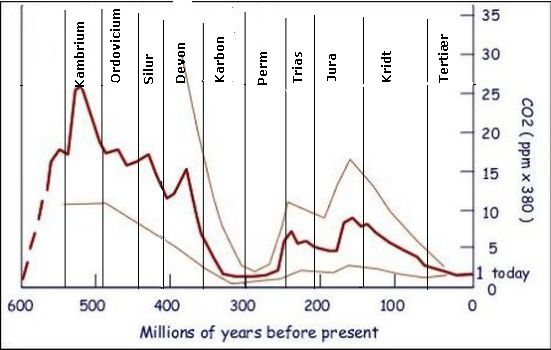
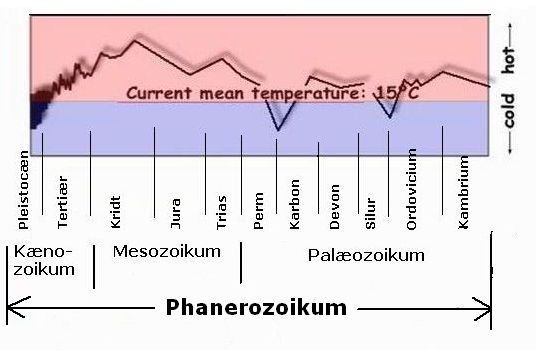
|
Top: The content of CO2 in the atmosphere during the Phanerozoic after Robert Berner Yale University. It can be seen that it had a maximum in the Cambrian and then declined with the exception of the minimum in Carboniferous time. There are several reconstructions of CO2 content in the atmosphere of the past, which are all different. But the trend is the same: in the greater part of the time, the concentration was much higher than in today's atmosphere.
Below: The planet's average temperatures following Anton Uriarte - but added the geological periods. It can be seen that temperature generally increased slightly until the middle of the Cretaceous period, after which it declined towards the Pleistocene ice age. In addition, the curve has a similar minimum at the other two ice ages in Phanerozoic, namely the Andean Saharan glaciation at the transition between Ordovician and Silurian and Karoo Ice Age in late Carboniferous and early Permian.
Through the entire Phanerozoic the content of CO2 in the atmosphere has been much
higher than in the present. Only at the end of the Carboniferous and at the beginning of the Permian the concentration has been as low as in modern times. The usual explanation is that the dead plants and trees were not oxidized by oxygen, but instead sank to the bottom of shallow swampy areas in oxygen-poor water.
Scientists have calculated past temperatures from analysis of sediments from the bottom of the Arctic Ocean, using the fact that the quantity of certain oxygen isotopes depends on the temperature when the sediment was formed. During far most of Phanerozoic the planet's temperature was significantly higher than in modern times. Only during ice ages temperature was lower. Apart from these glacial minima, temperatures during the whole period have increased slightly until the Cretaceous maximum, a process that may be attributed to the Sun's increasing brightness.
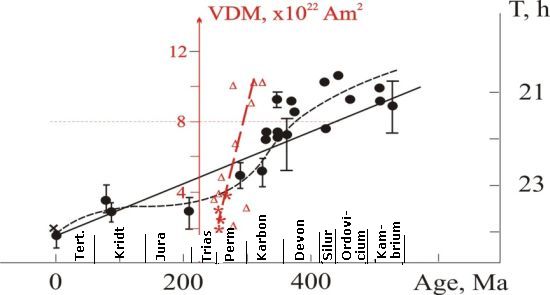
Length of Day and night through Phanerozoic - A research team from the "Geophysical Observatory" at "Institute of Physics of the Earth", Karelian RAS headed by VV Shecherbakova has compiled a database of Earth's "magnetic torque values" of the Earth (VDM). On this basis, they have calculated the Earth's orbital velocity through Phanerozoic - See link below. Points and triangles are direct measurements of respectively rotation and VDM values, the dashed black respective red line are regression-curves representing points and triangles, and the straight black line is a statistical linear regression representing the rotational speed of the earth, that is, diurnal length through Phanerozoic.
A team of researchers from the Russian "Institute of Physics of the Earth" in Karelia has calculated the Earth's rotation speed through Phanerozoic based on magnetic measurements. It can be seen that at the start of Phanerozoic a day and a night lasted a little more than 21 hours and, of course, at the end of Phanerozoic it lasts 24 hours.
Cambrian is the oldest part of the Paleozoic period. It lasted 54 million years, that is from 542 to 488 million years before present. Cambria is the Latin name for Wales, where Britain's Cambrian rocks are best exposed.

Petrified beach from the Cambrian. We see the distinctive imprint from waves and tides, there are some washed-up jellyfish and the so-called "Climactichnites Trackways" that is believed to be traces of some kind of snails. In that case, it must have been the first animal that walked, or let say crawled, on land. The jellyfish in the foreground is 10 cm. in diameter - from Blackberry Hill in Wisconsin in the United States.
Cambrian is special because of the unusually large number of fossils that are preserved to our days. This means that our understanding of the Cambrian fauna surpasses many of the later periods. We all know the Cambrian from the petrified trilobitess, that are so plentiful.
By the beginning of Paleozoic about 500 million years ago, almost all Earth's land masses were located in the southern hemisphere. North of 30 degrees northern latitude everything was covered with water. Many of Earth's continents gathered together to the supercontinent Gondwana, which stretched from the equator to the south pole and consisted of the minor continents South America, Africa, Arabia, Antarctica, Australia and India. Baltica, which included the part of the crust of the earth, which would later become Denmark, formed a separate island.
The continent Laurentia, named after the Laurentian Mountains north of Sct. Lawrence River in Canada, was also a separate island. The name Gondwana has been
derived from a native Indian tribe called "Gond" and means something like "Gond" country. But that's only a name; as everyone knows humans did not exist at that time.
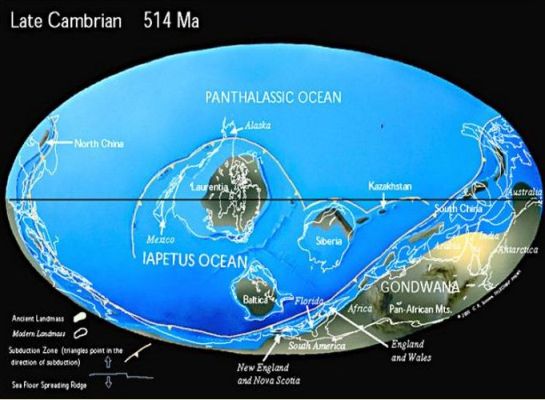
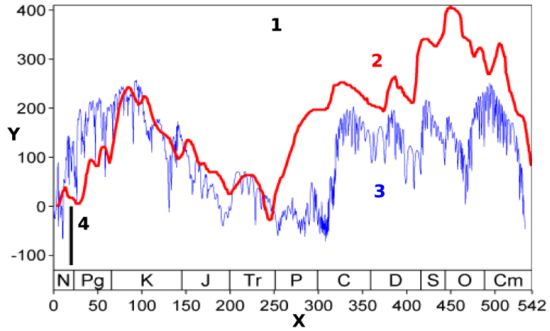
|
Top: The locations of the continents in the Late Cambrian. Gondwana has been formed close to the South Pole.
Below: Global Sea Surface Level Fluctuations in Phanerozoic. From
Wikipedia
It appears that it largely follows the temperature graph above. When it is hot, sea surface levels is high, and when it is cold, the water is bound as ice at the poles, and therefore the sea surface level is low. The Karoo ice age at the end of Carbon clearly appears with a very low water level, as does today's Pleistocene ice age, whereas the Andean-Sahara ice age at the transition between Ordovician and Silur does not seem to have caused a very low water level - at least in this diagram.
Y : Sea surface Level Change related to present (in meters).
X : Time scale in millions of Years.
2 : (Red curve) Hallam et al.
3 : (Blue curve) Sea surface Level Curve.
4 : (black bar) Scale of fluctuations of sea surface level in the Pleistocene.
Experts have very different opinions about when the atmospheric oxygen levels began to rise and reached today's level of 21%. Some believe that it happened as early as at the transition from Archean to Proterozoic. Others believe that it only happened at the end of the Cambrian.
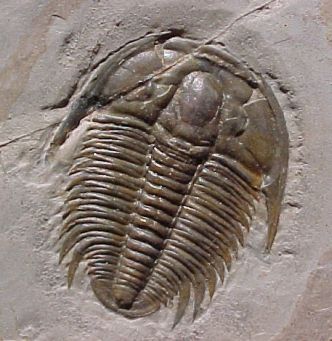
Typical Trilobite fossil from Cambrian - Note the incredible details.
The climate was warmer, than it is in the present, according to Anton Uriarte. But how much warmer is hard to say, maybe 5-10 degrees. There has been found no evidence of ice at the poles from this period. Earth's oceans also covered a greater part of the globe's surface, than they do today, which also indicates a warm climate.
In spite of the oxygen in the atmosphere, no universally accepted sign of life on land has been found from the Cambrian. The flat land must generally have been naked sand and rocks, barren and desolate. Life evolved and unfolded exclusively in shallow water at the coasts of the contingent. The inland landscape has most likely
been barren rocks, with a few patches of sand. It is possible that some areas of land have been covered with a green film composed of bacteria, algae or fungus. Such a green cover may have evolved even before Cambrian, although there is no direct evidence for it. Films of cyanobacteria have been found even in modern deserts, so it's easy to imagine that something similar could have existed in the geological past before there were any plants.
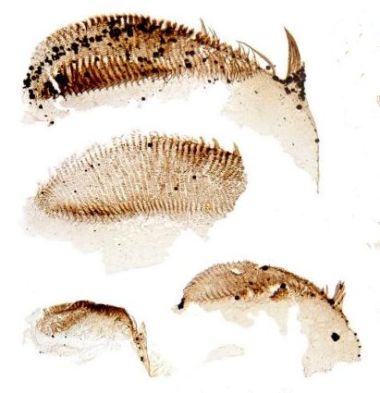

|
Left: Fossilized jaws of crustaceans from Cambrian found at Lake Riley in Deadwood rock formation in western Canada. It can be calculated that the body length of the crayfish was 10-15 mm.
Right: Graphical reconstruction of the fish Myllokunmingia, which was found in Yunan in China, it was 28 mm. long.
In Cambrian, the content of CO2 in the atmosphere increased to an absolute maximum for the entire Phanerozoic, namely 25 times today's concentration of 380 ppm, apparently without a corresponding increase in temperature.
Real plants need soil to grow in, but soil is made up of organic decay, and therefore also of plants. It may have been such a contradiction that for millions of years prevented plants from getting a foothold on land. But an organic layer formed by millions of years of decay of blue-green bacteria, and similar organisms could have been a breeding ground for real plants, which later should come.
The Ediacaran creatures soft bodies disintegrated quickly after their death and disappeared almost without a trace; but in the Cambrian animals emerged with hard outer skeletons that were well suited to produce fossils after death.
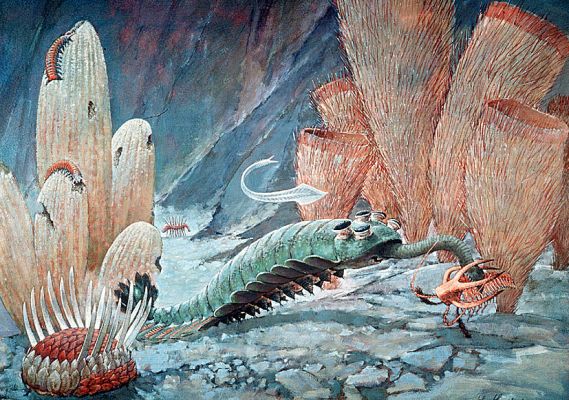
An artist's reconstruction of life at the bottom of the sea in the Cambrian. A trilobite-predator is chasing a primitive crustacean, while a primitive fish goes free. They are surrounded by creatures that look like millipedes, corals and sea anemones.
Trilobites lived in the ocean along the coasts of the Cambrian continents. They were one of the most successful of all prehistoric species. Several thousand different species of trilobites have been registered in a period that spans the entire Paleozoic. Some were outright predators, they hunted most likely other Trilobites, others lived on a kind of plankton or similar early organisms.
The earliest finding of trilobite fossils can be dated to the early Cambrian 526 million years ago. The last trilobite species died out in the mass extinction at the transition from the Permian to the Triassic about 250 million years ago.
The Burgess Shale rock formation in the Canadian Rocky Mountains is a very important finding places for fossils from the Cambrian. The fossils have unique details and also show soft parts of their bodies.
Here has been found the first complete fossil of Anomalocaris that was a kind of giant crustacean that could be more than half a meter long, a true giant for that time. It is believed that they lived on trilobites. It must have been a feared predator in the Cambrian waters.
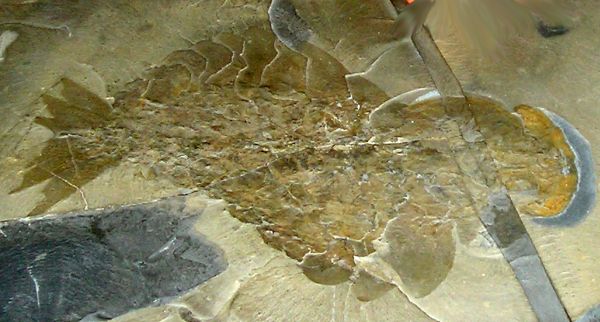
|
Fossil of Anomalocaris from Burgess Shale.
Near the city of Kunming in Yunnan province in China have been found a fossil of an animal that looks like a small fish, only 28 mm. long. It got the name Myllokunmingia. It has been dated to 524 million years before present, and it is believed that it is World's first vertebrate.
The first crustaceans, sponges, and coral reefs occurred in this period. The Cambrian seas were also breeding ground for mollusks, such as jellyfish and snails, which some think emerged already in the Ediacaran period at the end of Proterozoic.
Some scientists believe that the Cambrian was ended by an ice age or other mass extinction event because so many of the period's species are not found in Ordovician. But no pieces of evidences of such glacial period have been found.
Ordovician was really a natural evolution of Cambrian, and the reason that the period got its own name is said to be a discussion between two British geologists from the nineteenth century, Sedgwick and Murchison. One claimed that the period belonged to Cambrian, and the other said that the period belonged to the Silurian. Eventually, they settled to define it as a brand new period. Ordovician is named after a native Welsh tribe that the Romans called the Ordovicians.
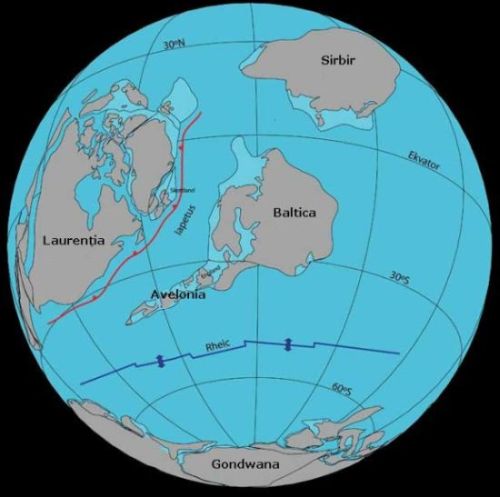
Earth's continents in Ordovician. The super-continent Gondwana was located at the South Pole. Laurentia, Baltica and Sibir were scattered in the Southern Ocean. Above 30 degrees north latitude was only water. The craton Avalonia had torn itself away from Gondwana and joined Baltica.
Ordovician lasted 44 million years that is from 488 to 444 million years before present.
The land was still deserted, in all probability void of plants and life. However there have been found a few fossils of plant spores, but it is not clear what kind of plants they represent. One can imagine that parts of the land could have been covered with bacteria cultures, perhaps cyanobacteria, primitive mosses and lichens all being growths, which do not leave fossils.
Part of the shale oil, that in a not distant future will be transformed into natural gas and exploited, has been created in the Ordovician. Shale oil is found in Estonia and Sweden among other places, which were more or less dry land in the Ordovician; then perhaps one should imagine that at least some places seethed with life also on the land in Ordovician, perhaps it was in lakes.
The super-continent Gondwana were located at the South Pole, and Laurentia, Siberia and Baltica were still isolated continents in the ocean.
The area of the earth's crust, that was to become Estonia, Sweden and Denmark, was part of the continent Baltica with the exception of a smaller part that belonged to the craton Avalonia, which had broken loose from Gondwana and united with Baltica. One can thus say that the foundation of Denmark was created in Ordovician.
The moon was still closer to Earth than it is now; how much closer is not clear. Accordingly, due to the physical law of conservation of rotational energy, the Moon's circulation around Earth must have been faster, that means the time between two full moons were shorter.
Additionally, the Moon has a tidal effect on Earth, causing Earth's rotation speed that is the diurnal length to slow down during time. Therefore, the diurnal length in Ordovician must have been somewhat shorter than it is now; it has been calculated to about 21.5 hours.
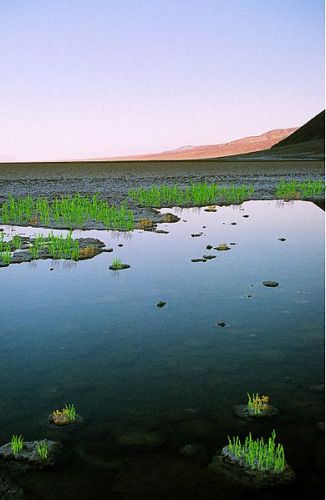
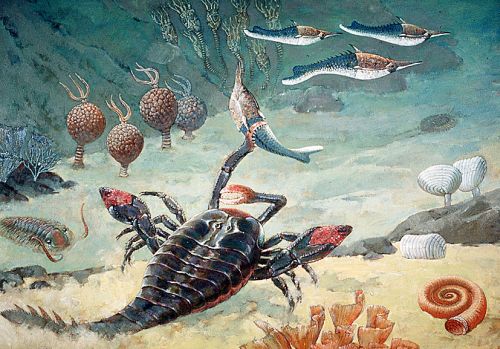
|
Left: Ordovician landscape - The artist describes that life in Ordovician unfolded under water, and land in general was barren and naked. - But, however, in order to create the mud to the many mud-eating animals on the seabed, there must have been some organic vegetation on land that could decay and then be washed into the sea by rivers.
Right: A reconstruction of life on the seabed in Ordovician - A sea scorpion captures a small primitive fish - in the background a snail, plankton-eating coral-like animals and a trilobite.
The content of CO2 in the atmosphere fell from the Cambrian maximum to the more moderate level of 17-18 times present level of 380 ppm, apparently without an equivalent change in temperature. Atmospheric oxygen content appears to have been just about 20%.
The sun's brightness was about 95% of todays, but nevertheless, the climate at the beginning of Ordovician was mild, perhaps 3-6 degrees above today's temperature. The sea surface level in the oceans was the highest of the whole of Phanerozoic, and therefore there were many warm shallow waters along the coasts of the continents, where many different creatures lived.
Layers from the Ordovician is characterized by rich deposits of fossils of trilobites, graptolites, corals, bryozoans, echinoderms, brachiopods and squids.
Trilobites thrived still in the warm waters. There were many different species of trilobites. Some were mobile sludge eaters, and others were predators. Some species developed the ability to scroll up like woodlice, other developed ability to swim, whereas they before could only crawl across the seabed.
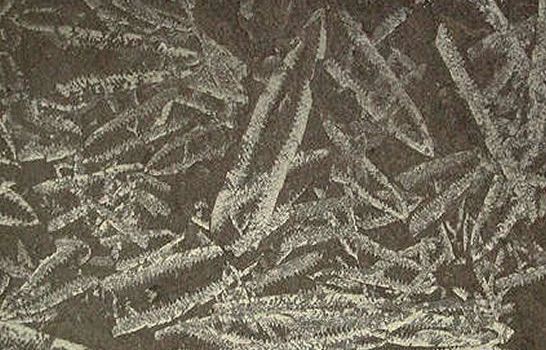
Fossils of graptolites.
Fossils of graptolites are very characteristic for rocks from Ordovician and
Silurianian. They were free-floating or stationary colonies of many identical individuals with chitin-armor. They filtered seawater for plankton. A graptolite colony was composed by many short tubes each less than 1 mm. long and each housing a graptolite individual, a "zooid".
On the south part of the Danish island Bornholm layers from Ordovician come to the surface, and here you can often find fossilized graptolites. The Swedish island of �land is almost entirely created of rocks from Ordovician.
The world's first coral reefs formed in Ordovician.
Bryozoans or moss animals were small colony-forming coral-like animals. They could fasten on solid surfaces such as seaweed, rocks or mussels. Bryozoans lived in Earth's oceans through billions of years, ranging from Ordovician to the Cretaceous period. Their skeletons are one of the main ingredients of precisely chalk.
Echinoderms are such animals as starfish, sea cucumbers and sea urchins.

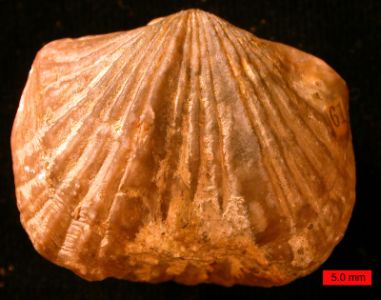
|
Left: Fossil of hyolit from Ordovician - Stenmuseet. Found in Nym�lle Grusgrav, P�rup on eastern Fyn by Peter Mortensen.
Til h�jre: The Brachiopod Vinlandostrophia Ponderosa from Ordovician.
Brachiopods resemble clams, but unlike those, who have left and right shells, brachiopods had upper and lower shells.
The newly developed octopus was the large dangerous predator in the Ordovician sea. They could grow up to 4.5 meters long and had an unknown number of arms.
Many of these species did already appear in the Cambrian and flourished in the following Ordovician. They came to represent the marine fauna throughout the Paleozoic until the big mass extinction at the transition from the Permian to Triassic. Some species, however, continued their existence up through the rest of Phanerozoic, and as you well know, many of them live still in the sea today.
In Ordovician lived also many mud-eaters, that is animals that got their food by passing large amounts of sludge or mud, like earthworms and lugworms. Tusk shell is a sludge-eating mollusc that is fairly unchanged since Ordovician. Hyoliths were also a kind of mud-eating animals in chalk-shell. Many trilobite species also got their food by eating mud.
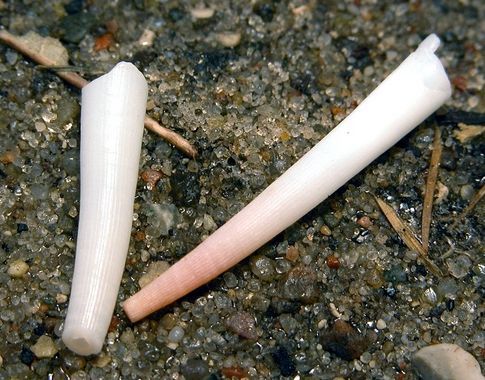
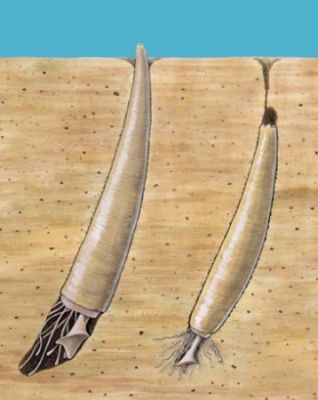
|
Left: Modern tusk shells
Right: Tusk shells are mud-eaters. They live buried in the sea bed.
But mud in shallow coastal waters is formed by organic decay on land that is washed into the sea by rivers. Therefore, the existence of sludge-eating creatures in Ordovician indicates that there must have been some organic vegetation on land, which produced the organic content in the mud.
In 2010 five different types of fossilized liverworts were found in Argentina that were dated to middle Ordovician. These are the oldest known fossils of stem plants. Liverworts are very primitive plants, more primitive than common mosses; they are both aquatic and terrestrial plants. Furthermore, fossilized algae from the Ordovician have been found in the United States.
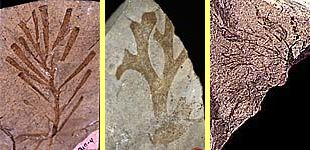
Fossils of algae from the Ordovician found in the United States. From left to right winnipegia cuneata, manitobia patula and kinwowia articulata.
Stromatolites represent a symbiosis between blue-green bacteria and other bacteria, they existed billions of years before the Ordovician, and they still exist. Therefore, they must also have existed in the Ordovician. There may well have been different forms of such symbioses.
It is reasonable to assume that the land at that time was covered with different
primitive mosses, algae, lichens and bacteria, which in general were so soft that they left no fossils.
At the end of the Ordovician, there was a violent event on Earth that wiped out 85% of all species. It is generally assumed that it was one or more ice ages that is called the Andean-Saharan ice age. It covered the current Sahara and Amazon areas, which were then a part of the supercontinent Gondwana, located at the South Pole.
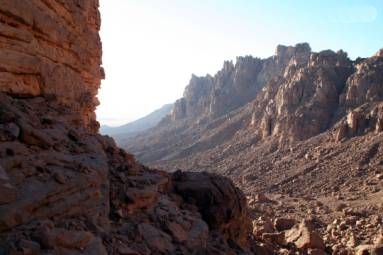
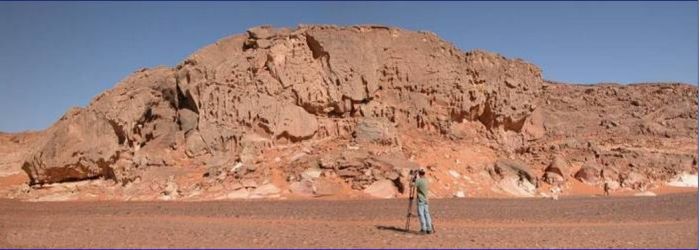
|
Top: U-shaped glacial valley in Jabal Arkenu in southern Libya.
Below: The front of the Kufra Basin in southern Libya is made up of sediments from the Andean-Saharan glaciations in Late Ordovician and Early Silurian. The ice extended against North-west.
Geological findings suggest that the desert was then covered by a thick layer of ice. The glaciers covered more than 8 million km2 from the Massif du Hoggar in southern Algiers to the Mauritanian Atlantic coast. The sea surface level fell dramatically, and the extensive shallow waters along the coasts of the continents were turned into dry land. This caused the great mass extinction during the transition from Ordovician to Silurian.
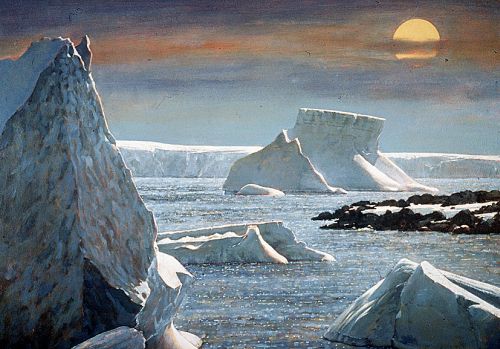
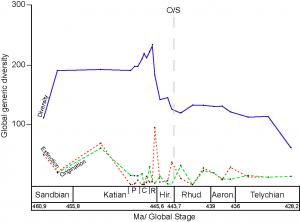
|
Left: Reconstruction of the Andean-Saharan glaciation in the Late Ordovician and Early Silurian.
Right: Decrease in biodiversity during the transition from Ordovicium to Silurian. - O/S means Ordovician/Silurian, the names below: Sandbian, Kattian etc. represent subdivisions of these two geological periods. The blue graph represents the number of species as a function of time.
The ice age lasted for about 2 million years. The remains of large furrows and grooves created by the Andean-Saharan ice sheet can still be seen today. At the foot of Massif du Hoggar in southern Algiers is a typical U-shaped glacier valley with polished rocks and low elongated hills, all of which indicate a past ice age.
One paradox in connection with the Andean-Saharan ice age is that the CO2 concentration in the atmosphere remained rather high compared with today's level. Some findings even show that the CO2 concentration was up to 16 times today's level.
Therefore, it is likely that it was geographical or astronomical factors rather than the atmospheric chemical composition, which was the determining factor in the creation of the Hirnantian Ice Age that the Andean-Saharan Ice Age is also called.
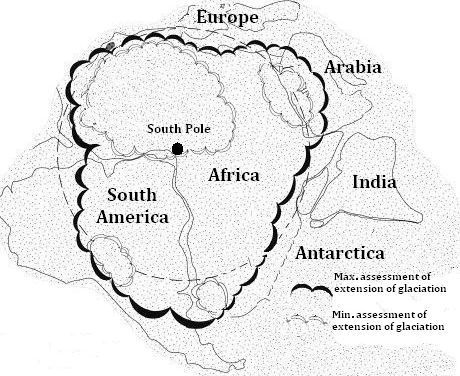
The extension of the Andean-Saharan ice age ice sheet following "Late Ordovician sedimentary environments, glacial cycles -." There are different assessments of
how large an area that was covered by the Andean-Saharan glaciation.
The maximum assessment tells us that all of Africa and most of South America was
covered by ice. The minimum assessment says that West Africa and the areas around the Red Sea, the Andes and South Africa was covered by ice."
The Danish geologist Christian Mac Orum Rasmussen and his colleagues have suggested that geological processes and not climate were responsible for the extensive extinction of species at the transition between the Ordovician and Silurianian. So to be understood that the great richness of species in the Ordovician was found along the coasts of some small islands near the continent Laurentia. However, because of plate tectonics, the smaller islands were united with Laurentia, and therefore there was no longer the same living conditions for the many species. (see link below)
Silurian is named after another ancient Celtic tribe in Wales, called the
Silurians by the Romans. The period lasted 28 million years, namely from 444 to 416 million years before present.

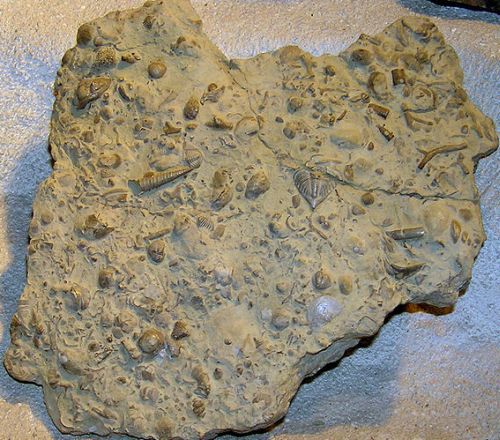
|
Left: Fossil of a plant from Silurian
Right: A small piece of fossilized seabed from shallow coastal waters in
Silurian. There is the trilobite Dalmanites, the coral Favosites, bryozoans including Favositella, brachiopods including Atrypa. From Wenlock Limestone, Dudley, West Midlands - England.
After the Andean-Saharan ice, age the temperature rose again, and the climate remained warm and humid through the rest of the Silurian, Devonian and most of the Carboniferous. The heat and the high content of atmospheric CO2 created conditions for that land became overgrown with lush vegetation. The new vegetation consisted of vascular plants, which had a stiff stem, allowing them to grow upward. They were such plants as ferns and horsetails.
We know that gardeners can raise the level of CO2 in the air in their greenhouses, and this will make plants grow much faster. Something similar happened in the Devonian period, the warm, humid climate and the high concentration of CO2 in the atmosphere caused the vascular plants to colonize all continents with a host of new fast-growing plant types. There was probably extensive "forests" of mosses and lichens, ferns and horsetails.
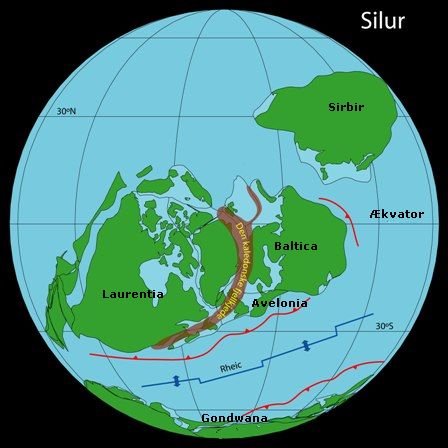
Map of the World in Silurian. The part of the Earth's crust, which was to become Denmark, stayed near the equator, as part of the continent Baltica and the craton Avelonia. They had united with the North American Laurentia, Greenland and some small cratons in this way creating the Caledonian mountain-raising.
The glaciers of the Andean-Saharan Ice Age melted, so the sea surface level in the World's oceans became quite high, creating extensive warm shallow sea areas, where life thrived. Here lived reefs of coral and other reef builders such as bryozoans and some prehistoric sponges called stromatoporoides.
The sun shone with about 95-96% of its current brightness. Day and night lasted barely 22 hours. The temperature in the Silurian after the ice age was maybe around 3-6 degrees higher than today's. The oxygen content in the atmosphere was about 16-17%. The CO2 content in the atmosphere was about 20 times today's level; it is hard to see it could come from other sources than volcanism.
The supercontinent Gondwana was still located on the southern hemisphere surrounded by some smaller continents. These included Baltica and Avelonia which had joined Greenland and Laurentia and some small cratons. These smaller continents pressed against each other, and thereby they pushed up the Caledonian mountains that include the mountains along the east coast of Greenland, the English and Scottish mountains, the mountains along the northern part of the U.S. east coast and the north German mountains in Avelonia.
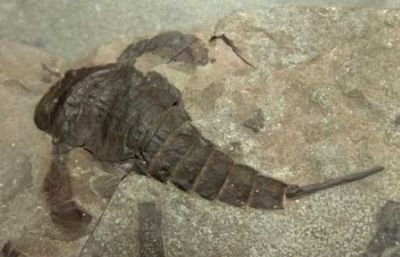
A fossil of Eurypterid or sea scorpion.
The northern hemisphere was mostly one large ocean. Like the waters south of Cape Horn today waves could roll around the globe and amplify for each orbit. We must believe that the Northern Sea has been characterized by raging storms and huge waves.
Finally, life on land emerged. The earliest evidence of life on land are remains of such creatures as scorpions, arachnids, centipedes, spiders, mites, reapers and millipedes. The first leeches also appeared in this period.
Just as today continents' interior seems to have been more dry and desert-like than the coastal areas.

The fish Psarolepis had a spine, internal skeleton and jaws. It was found in South China. The length is approximate 10 cm. - Drawing by NTamura.
The decisive event for marine life was the development of real fish with
internal skeleton, spine and jaws. In South China a fossil of a fish from the Silurian with jaws, spine and internal skeleton has been found. It is named Psarolepis and was about 10 cm. long.
In the shallow muddy waters near the coasts also lived a formidable predator called Eurypterid or sea scorpion. It is said that they could be up to 2 meters long. Presumably, they lived of fish.
Devonian lasted 57 million years, namely from 416 to 359 million years before present. The period is named after the county of Devon in southern England.
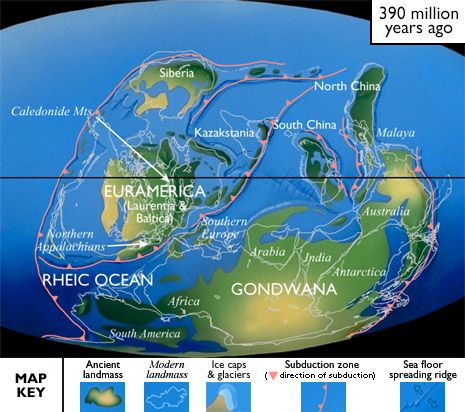
Map of the World in Devonian. The supercontinent Gondwana still exist, but it has moved a bit away from the South Pole. Laurentia, Baltica and a number of other small continents, including Avalonia have united as a large new continent that some have named Euramerica.
Even though the sun only shone with about 96% of its current brightness, the warm climate of the Silurian continued into the Devonian and lasted through the entire period. The temperature was maybe about 3-6 degrees higher than today. The sea surface level in the world's ocean was high, but for unknown reasons, it decreased slightly compared to the Silurian.
Day and night lasted about 22 hours. The oxygen content of the atmosphere was rather low, about 16-17%.
The CO2 content had decreased in comparison to the Devonian so it in Silurian was only about 15 times today's level. However, towards the end of the period, the CO2 content again decreased significantly towards the minimum of Carboniferous and Permian. It is assumed that carbon, bound in organic growths, did not recycle to the atmosphere, but instead sank to the bottom of swamps and marshland and formed fossilized hydrocarbons like coal. Part of the fossil reserves, which we extract today, was formed in end of Devonian.
Devonian is often called the age of fishes because so many different species of fish have been found from this period. Both lobe-finned and ray-finned fish and primitive sharks originated in Devonian.
The most fearsome fish were the armored placoderms. There have been identified more than 200 types of placoderms, the first appeared in the early Silurian, but most can be attributed to Devonian. A few of them could be up to 10 m long. Trilobites, brachiopods and various builders of large coral-reefs were still widespread.
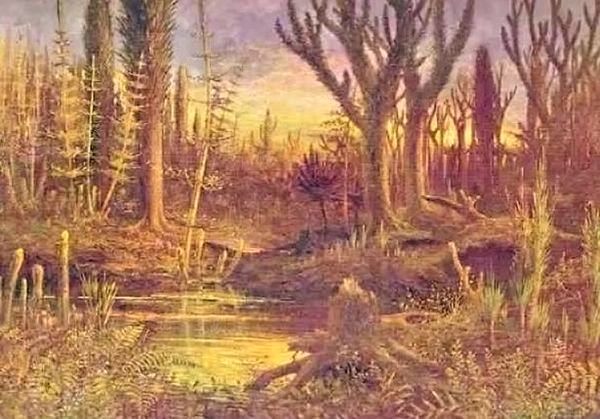
|
An artist's reproduction of a landscape from the Devonian period.
In Devonian, the early vegetation developed into real plants with primitive roots. At the end of Devonian appeared the first seed plants. The ground got a stable supply of decomposed organic substances that mixed with the original sand and gravel became to soil, which in turn gave opportunities for new plants. The decaying plants also provided new habitats for mites, centipedes, millipedes, scorpions and spiders that had already emerged in the Silurian.
At the beginning of Devonian the original vascular plants, that is ferns and horsetails, were not very tall, maybe about one meter. But in the late Devonian appeared growths that were was several meters high. There have been found fossils of tree-like growths almost 30 meters high.
Also, the first fossil insects have been found in layers from the Devonian period.
In the Zachelmie quarry in "Holy Cross Mountains" in southeastern Poland have been found footprints from four-legged animals in layers from Middle Devonian. There are traces from several individuals. It is estimated that the length of the animals has varied from nearly half a meter to two meters from snout to tail. They looked like lizards and crocodiles, and their way of walking was similar to these animals. They had six toes or claws on each foot.
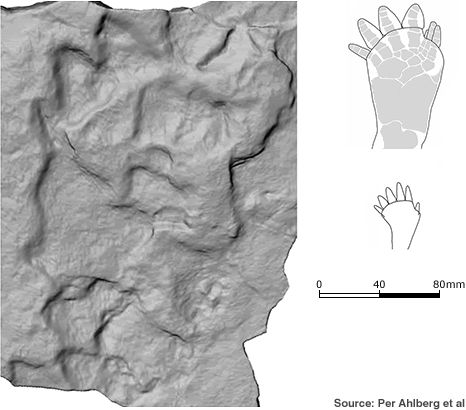
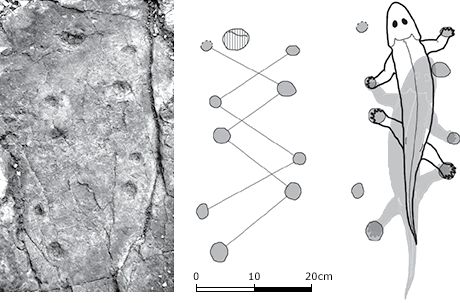
|
Left: Fossilized footprints of a four-legged animal from Devonian found in the Zachelmie quarry in Poland. Drawing by Per Ahlberg. - This one seems to have had six toes or claws.
Right: Fossilized footprints from Devonian found in the Zachelmie quarry. The animals way of walking is reconstructed by Polish and Swedish paleontologists.
The Polish and Swedish paleontologists, who examined the footsteps, think that a group of these animals lived at a muddy coast behind a coral reef in the Devonian period. Every day at low tide, they ran across the muddy bank to eat the mussels and other animals that the sea had left as it retreated.
This is the first evidence of four-legged animals on land. It is believed that they have evolved from the lobe-finned fish, which was a group of large predatory fish that we know from fossils and other sources. They were characterized by their tassel-fins that were supported by muscles and bone structure almost like skeletons of land vertebrates. Usual modern fish, such as cod and herring, are called ray-finned.
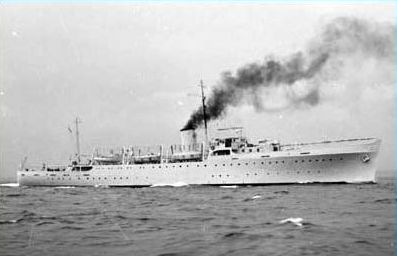
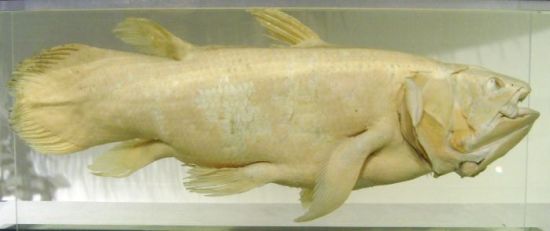
|
Top: Galathea 2 steams out in 1950. The expedition lasted for two years. The frigate had a crew of 100 sailors and scientists.
Below: The blue fish, coelacanth, Latimeria, in the Zoological Museum of Copenhagen. Alive the fish is blue, but the color fades away very quickly after it has been taken up from the sea.
In 1950 the Danish Galathea expedition found "The Blue Fish", Latimeria, off the coast of South Africa. Until then, the world had only known it from a half rotten sample landed by fishermen in South Africa in 1938.
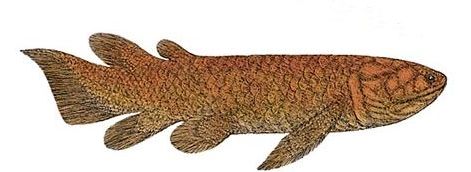
Reconstruction of a lobe-finned fish from Devonian.
The blue fish belongs to the lobe-finned fish that before 1938 only was known from fossils. Until then it was thought that they had become extinct in the Cretaceous period 65 million years ago. Until this day only about 200 of these living fossils had been caught.
Their characteristic lobe-fins resemble terrestrial vertebrate's limbs. The fins are supported by an internal skeleton, which also bears some resemblance to terrestrial vertebrates. They have a joint behind the head, which allows them to move their head up and down independently of the body's position.
They live in deep waters in the world ocean, where they can be more than 100 years old. They can grow up to 2 m long and weigh up to 95 kilos, which is basically the same as humans. However, they are usually smaller, especially the males that often have the length of only about 1.65 m. Their eggs are fertilized inside the female like it is the case for mammals. The eggs are about 10 cm in diameter, and a newborn young fish is 35 cm long. The females get between 5 and 25 at a time.
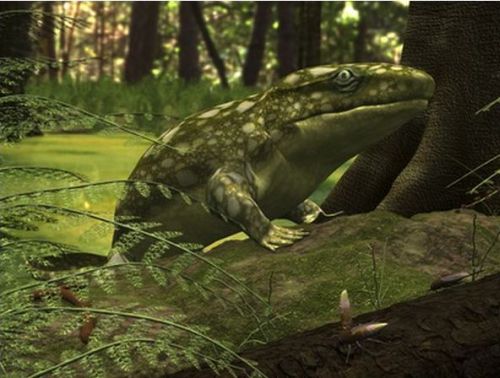
An tetrapod is going ashore.
But it becomes even more interesting. Lungfish, which are equipped with lungs in addition to gills, also belongs to the group of lobe-finned fish. Lungfish have been found as fossils in layers from the beginning of the Devonian period. The oldest forms lived in salty water, but they quickly adapted to life also in freshwater. In Devonian lungfish were widespread, and the number of species was the highest ever. Lungfish still live in Africa and Australia.
Now, one can imagine that the first tetrapods (tetra means four, and pods means feet - that is four-legged animals) went ashore in the Devonian period as follows: Some lobe-finned fish with small bulges in the esophagus, which served as lungs, landed on some muddy shores. They used their powerful tassel-fins as legs. Maybe they in this way they could better escape giant octopus' and sea scorpions on the prowl. Now and then they went out into the water and found some food, where after they immediately crawled back to the safety on land. Over time they also developed the ability to obtain their feed on land in form of plants, snails, insects and other animals, which were already there. And from these first four-legged creatures with internal skeleton descended reptiles, dinosaurs, mammals and, ultimately, humans.
However, it is still puzzling that such a fish like the blue fish with the limb-like lobe-fins and corresponding skeleton could develop in the sea. It is easy to imagine that it could have been a kind of whale, so to say, that it could have been an animal that had developed on land and later on returned to the sea - like the whale.
The Gondwana continent had left the South Pole and begun to float to the north, where it came ever closer to Euramerica, which was composed of Laurentia, Baltica, Avelonia and some other small continents. Ice had begun to form in the southern part of Gondwana.
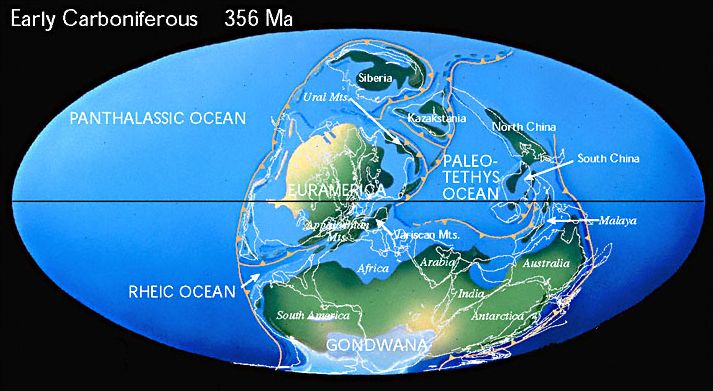
|
The World in Early Carboniferous - Gondwana had moved to the north and approached Euramerica. There was beginning ice in the southern part of Gondwana. The entire northern hemisphere was mainly ocean. There were no continents extending from North to South obstructing the east-west currents in the ocean. One must believe that the seas have been characterized by enormous waves in the same way as today in the waters south of Cape Horn, where currents and waves can move freely around the globe and amplify for each encirclement.
In Carboniferous, the duration of day and night was just over 22 hours. The sun shone with 97-98% of its current brightness, but the climate was never the less hot and humid, maybe the temperature was 6-8 degrees higher than present-day temperature. Some think that Carboniferous' average temperature was 20
degrees that can be compared with world average temperature today that is
about 14 degrees and with Denmark's average temperature today that is 8 degrees.
Carboniferous got its name after the huge quantities of coal from that time, which we can retrieve from the underground. In Carboniferous, the old and fallen trees sank to the bottom of stagnant water in extensive swamps and marshes without rotting or burning. As time passed by, they were covered by other trees and new sedimentary layers, and in the course of time, they were transformed into coal.
One may wonder why there were so many swamps at this time, shouldn't we think that the amount of water in the world surely must remain relatively constant?
Earth's first continents were fragments of solidified crust that floated around
on liquid magma. Basically, it is still the case, but the fragments have only become thicker and do not flow as fast anymore. The initial small continents were flat as pancakes, or should we say flat as ice floes, which after all roughly are created in a similar way.
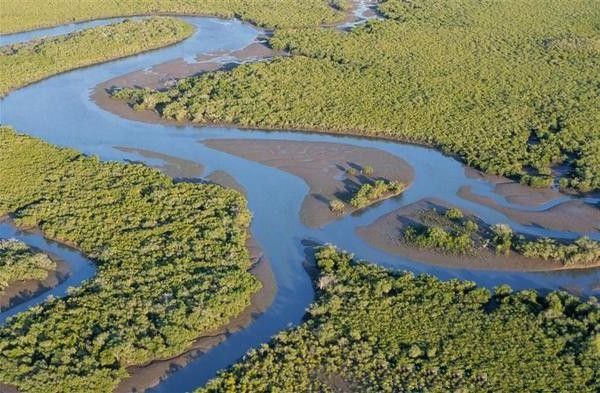
|
Gladstone Mangrove
Marsh in Australia - The Swamp forests of Carboniferous may have looked
like that.
Only when the original small continents, also called cratons, gathered to major continents, they began to push each other, and thus they folded and created mountains.
The Cambrian Mountain-erection, which took place in the Cambrian and Silurian, created some of the world's first and oldest mountains that we can see in Wales
and East Greenland. But most and highest of the Earth's mountains are much younger than them. For example, the Himalayas and the whole Tibetan Plateau was first created in Tertiary after the Indian continent hit the Eurasian continent. The Alps were also created a few million years ago when Africa began to press against Europe.
But in Carboniferous, the world was in general still flat as a pancake. The climate was hot and humid, and the water from the never-ending rain had difficulty to run away in the flat landscape. It created huge swamp landscapes with stagnant water poor of oxygen.
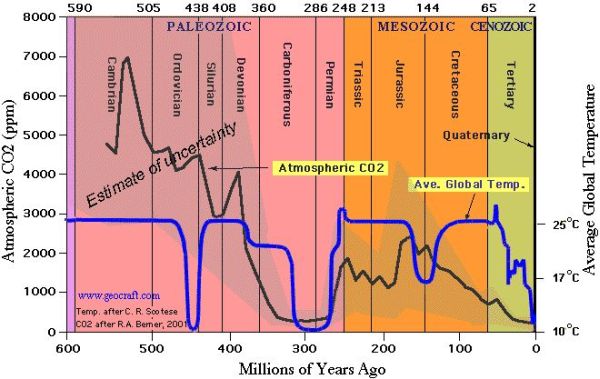
|
A total presentation of atmospheric CO2 and average global temperature during Phanerozoic. - It is easily seen that the atmospheric CO2 and global temperature have only little correlation.
When the new fast-growing trees of the Carboniferous fell for storm and tear, they sank to the bottom of the stagnant oxygen-depleted water, without being oxidized by burning or rotting. In this way still more carbon was taken out of the world's carbon cycle and therefore the atmospheric CO2 sank to a historic minimum, as it shrank to less than 400 ppm (parts per million), which also
roughly is the CO2 content of today's atmosphere.
Conversely, the oxygen content in the atmosphere raised to extreme heights, namely from 25 to 35%, which has to be compared with the present-day level of 21%. This was probably the oxygen, created by the photosynthesis of the many trees, which eventually no longer was able to find something to oxidize. All iron, methane, carbon and other oxidizable compounds were already used, and the fallen trees were immediately covered with oxygen-poor water.

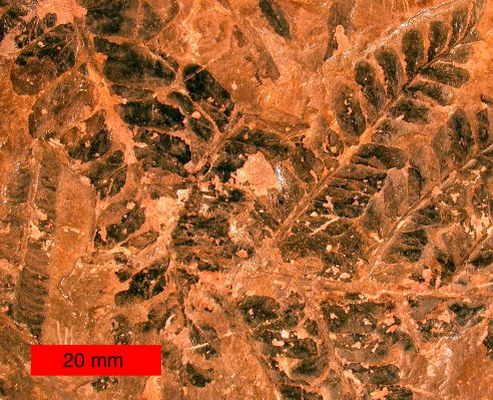
|
Top: An artist's reconstruction of a Carboniferous landscape with ferns and
the high lycopod trees with green stems.
Below: Fossils of the fern-like pteridosperm from the Carboniferous.
Trees transformed to coal found in coal mines show no signs of growth rings, so one can conclude that differences in seasons were minimal. The mild and humid climate all over the globe was most likely due to that the continents were located in a way that allowed the water to flow freely distributing the heat without being blocked by land masses, which stretch from North to South - like today's.
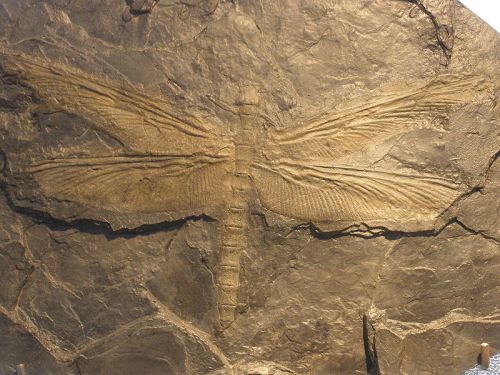
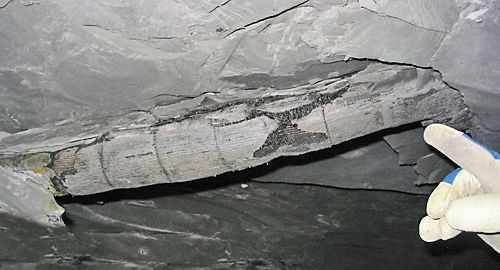
|
Top: Meganeura fossil, Meganeura was a kind dragon fly from Carboniferous,
which could achieve a wingspan of 75 cm.
Below: A piece of calamites from a coal mine.
The Euramerica continent was located pretty near equator and was covered by tropical swamp forests, which by their decay formed most of the Western European and American coal deposits. The forests consisted partly of the fern-like, but seed-bearing, Pteridos Permian, the up to 35 m. high Lepidodendrale Lycopod with green stems and Sphenopsid Calamites, which could be 20 meters high.
Gondwana, which was located further down towards the southern Arctic regions, had its own more sparse fauna.
Many species in Carboniferous developed the ability to reproduce by
amniote eggs, which are eggs that are designed to develop on the ground and not in water. In the amniote egg, the embryo is surrounded by various membranes and a shell that protects it simultaneously making it possible to absorb oxygen.
Many different species of tetrapods thrived on land. Some looked like crocodiles or salamanders, others resembled lizards or snakes.
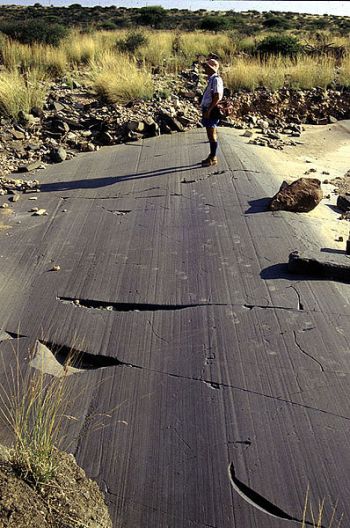
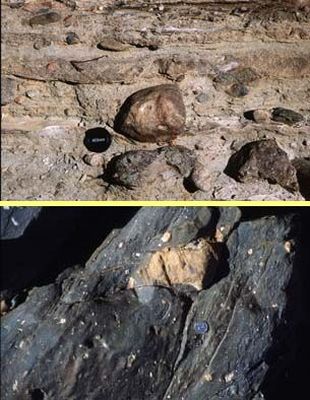
|
Left: Polished rock from the Karoo Ice Age near the town of Douglas in the Karoo region in South Africa.
Right top: Moraine deposits from the Late Carboniferous Karoo Ice Age found in the Parana Basin in Brazil, called Waick-tillite.
Right bottom: Moraine deposits from the Late Carboniferous from the Karoo Basin in South Africa called Dwyka tillite.
It is believed that already in Carboniferous developed two main types of tetrapods namely Saoropides and Pelycosaurs. From Sauropides descend lizards, snakes, crocodiles, dinosaurs and birds and from Pelycosaurs descends mammals.
Insects and flowering plants belong together, and they also appeared simultaneously in Carboniferous. Insects could be very large. Meganeura was a kind of dragon fly, which could have a wingspan of 75 cm. Many believe that Carboniferous' very high oxygen content in the atmosphere was very favorable for insects.
Karoo Ice Age is named after the Karoo Basin in South Africa, where typical glacial sediments from this period have been found. The Karoo ice age is divided into two periods, namely from 359 to 318 million before present, and from 318 to 299 million years before present.
This ice age lasted exceptionally 60 million years. Roughly it occupies the second half of the Carboniferous and the first half of Permian.
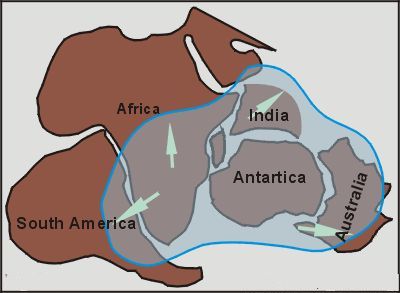
Schematic representation of the continents that formed Gondwana with the glaciation of the Karoo Ice Age plotted.
The glaciations extended primarily on the southern hemisphere flowing from the base of Southern Gondwana. On all continents, that once were part of Gondwana, have been found evidence of the Karoo Ice Age. One can find moraine layers in the Karoo basin of South Africa, Talchir Boulder Beds in India, Wynyard rock formation on Tasmania and the Parana Basin in Brazil.
Layers from the Karoo Ice Age exhibit very often cyclical repetitions, which indicates that a sequence of actual ice ages was interrupted by inter-glacials at regular intervals. As we know, such cyclical repetitions are also a characteristic of our present Pleistocene ice age.
The northern hemisphere was covered by sea, probably with huge waves, and there could probably not have been formed real glaciations.
Unlike previous ice ages, it is striking that this extremely long ice age occurred in a period with very low levels of CO2 in the atmosphere.
In the Permian, all the earth's continents gathered in one single large C-shaped giant continent over the equator called Pangaea. The sea within the C is called the Tethys Sea, and the remaining of the worlds ocean is called the Panthalassic Sea.
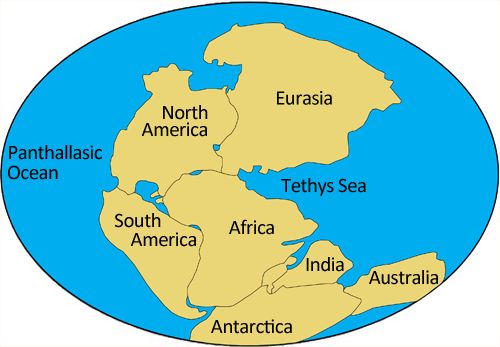
A simplified representation of Pangaea
Permian was the last period of the Paleozoic. It lasted 48 million years,
namely from 299 to 251 million years before present. The period has been named after the Russian city of the same name, as it was here that layers from this period first was found.
The sun shone with about 97% of its current brightness, and day and night lasted about 22.5 hours. Atmospheric CO2 concentration was very low and in line with the level of today; however, in the last quarter of the period, it again started to rise towards the maximum of the Cretaceous. Atmospheric oxygen content decreased throughout the period from an all-time high of 35% in Carboniferous to the more modest level of 22% that is in line with today's oxygen level.
The Karoo Ice Age lasted well into the Permian period, and the climate has likely been pretty cold. But at the end of the period, the temperature
did reach a few degrees higher than today's temperature.
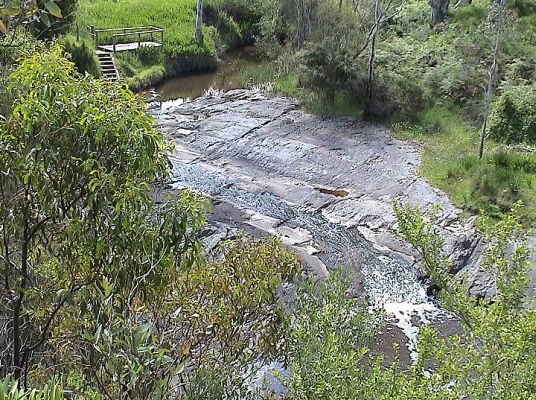
Rock that has been polished smooth by the Karoo glaciers in the Permian - Selwyn Rock, South Australia south of Adelaide near the town of Victor Harbor - In Ihis area also many other traces of the Ice Age can be found, among other various moraine deposits.
Pangaea was a huge continent and contained extreme climate and environmental conditions. The southern part was cold and dry, with large parts of the region frozen in glaciers. The coastal areas were hot and humid, while the continent's interior suffered from dryness and desertification. Some lakes simply dried out during Permian. In Northwest Europe, especially in Germany thick layer of salt deposits from Permian have been found and on Spitsbergen has been found a thick layer of salt and gypsum, which is typical for dried out lakes.
The equatorial regions, especially near the Tethys Sea, were covered by
extensive swamps. This part of the Earth's crust is now the southern region of China, where large deposits from the Permian have been found.
It is believed that most of Pangaea had a very pronounced continental climate.
The monsoon is a steady wind blowing from sea to land or from land to sea due to temperature differences between land and sea. In summertime, it is likely to give rain along the coast and on high mountains.
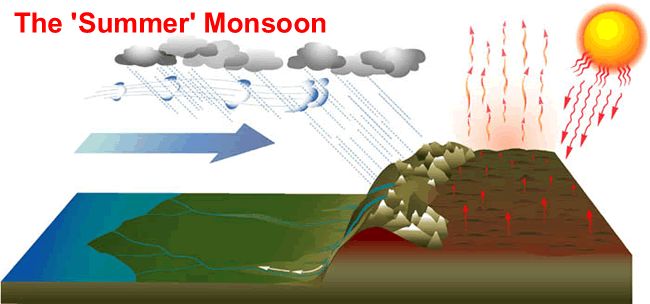
|
The most well known monsoon today is the southeast Asian monsoon that brings the rain to India and other countries. The hot and humid air is forced over high mountains and releases thereby its humidity as rain. In Permian the Pangaea was an even bigger continent, creating an even more powerful monsoon; however the mountains of that time were few and not very high, so it is assumed that the Pangaean monsoon was powerful but did not give very much rain.
In the summer the sun heats both land and sea, but the temperature on land is rising faster than the temperature of the sea. Rocks and soil have a poor thermal conductivity and a small heat capacity, and therefore, the temperature rises rapidly on land. Water, however, can absorb much more heat from the same solar radiation without a rise in temperature, because water has a high thermal conductivity and high specific heat capacity, and furthermore the heat is quickly distributed to the deeper ocean by waves and currents.
When the land masses are heated in the summer, the warm air rises into the sky, and this will create a low pressure. The warm moist air over the ocean will then flow in and attempt to fill out this low pressure, and this wind is the monsoon. In winter, the sea can be warmer than land and then the monsoon blows from land to the sea.
The larger land mass that borders to the larger ocean, the more pronounced will the monsoon winds be. In principle, there may be monsoon winds all over the world, but today the East Asian monsoon is the most famous because here a big continent is bordering a very large and warm sea.
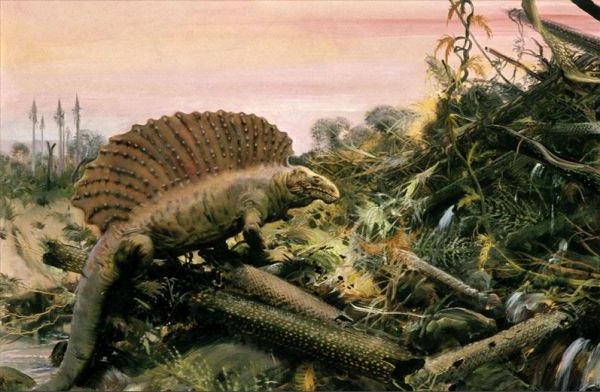
|
Artistic production of the predator Dimetrodon from the Permian. - It
descended from Carboniferous' Pelycosaurer. It looks undeniably some lizard-like, but it has in all probability features characteristics of the later mammals. Many believe that it was warm-blooded and that its characteristic back-fin served the same purpose as the elephants' large ears, namely to form a big surface, where it could get rid of the heat.
Pangaea was the largest continent ever, and it was surrounded by an equally huge ocean, namely the Panthalassic Sea covering the rest of the Earth's surface. It is believed that the shores of Pang�as must have been exposed to very strong monsoon winds.
We have all heard of the continental climate of the interior of Eurasia, shall we say in Kazakstan or Mongolia. The summers are terrible hot with temperatures reaching 40 degrees, and winters are icy cold with similar minus temperatures. It is, of course, because Eurasia is such a vast continent with a long distance from its interior to the sea and its big heat content.
Pangaea was a much bigger continent, probably with an even more pronounced continental climate. There can be no doubt that winters in central Pangaea must have been a very harsh experience, and summers must have been unbearably hot.
Several mountain ranges were created, when the many continents pushed toward each other creating the supercontinent. Among others, the Ural Mountains was created in Permian. We must also believe that their pressure against each other gradually created a higher level in the interior of the continent so that the rivers could drain the land more efficiently, than they did in the Carboniferous, making the water stream from the mountains and down into the sea, as it does today.
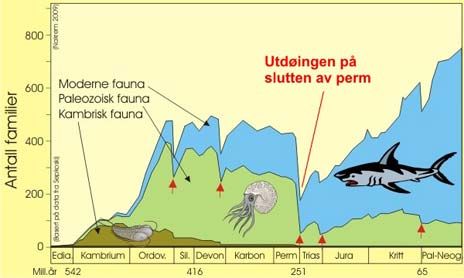
Mass extinction at the transition from Permian to Triassic - Hans Arne Nakrem, University of Oslo.
But still no Alps and no Himalaya had emerged, and the monsoon wind blowing from the sea into the land was not forced to release its humidity in the same ultimate way, as it is the case today in southern Asia, when the wind is forced over high mountains. All that we know is that the interior of Pangaea was very dry and desert-like.
The lush swamp forests of the Carboniferous were gradually replaced by conifers, seed-bearing ferns and other drought-resistant plants. The oldest ginkgo trees have been found in layers from the end of the Permian.
In this barren and arid climate lived the descendants of the Carboniferous period's Sauropids and Pelycosaurs. The Sauropids became the ancestors of numerous bird and dinosaur species, and the Pelycosaurs became extinct in the following Triassic period, but however not until they had developed a separate side branch, namely mammals.
At the end of the Permian, the world experienced a mass-extinction in an unprecedented scale. Over 90% of all species disappeared during a short time. In the sea approximately 95% of all species became extinct. Trilobites, sea scorpions, many species of coral, moss animals, lizards, insects and plants disappeared forever.
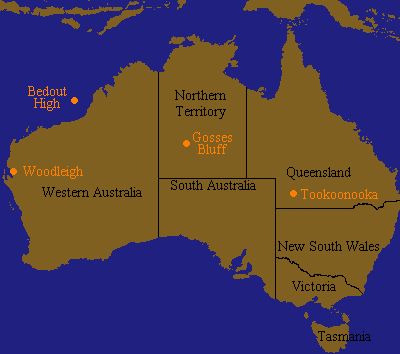
Big Australian meteor craters.
It can not be said with certainty, what was the cause, but some point to extensive volcanic activity. At the end of the Permian the continent Sibir was on fire. Large areas of modern Siberia consists of basalt rocks from just this time. Huge volcanoes sent a stream of toxic gases, CO2, and particles into the atmosphere. Acid sulphurous rain may have poisoned the marine environments. Potent greenhouse gases may have caused the temperature rose dramatically; it has been shown that the global temperature increased 5 to 10 degrees. Melting of the Siberian Permafrost can have released large amounts of methane, which is an even stronger greenhouse gas than CO2.
Another proposal for an explanation of what happened is that the Earth was hit by one or more giant meteorites. It is believed that the disaster occurred on a single fatal day.
The underwater Bedout High crater is located 300 km north-west of the Australian coast. It has been dated to the end of the Permian period about 250 million years before present. It is estimated that its original diameter has been 200 km., which is of the same magnitude as the dinosaur killer, who created the Chicxulub crater in Mexico.
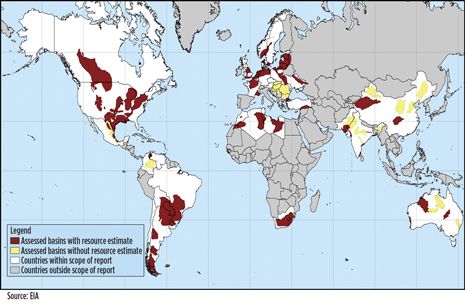
Assesment of oil shale deposits around the world - Most oil shale deposits were formed during Middle Cambrian, Early and Middle Ordovician, Late Devonian, Late Jurassic and Paleocene - From World Oil.
In 2004 a large crater-like structure was detected under the almost two kilometer thick East Antarctic ice sheet. The Wilkes Land crater can be more than five times the size of the Chicxulub crater. It has been tentative dated to about the transition from Permian to Triassic.
Most oil shale deposits, that we today hope to exploit, were formed during Middle Cambrian, Early and Middle Ordovician, Late Devonian, Late Jurassic and Paleocene. They are thought to be a kind of organic deposits from algae.
|
University of California Museum of Paleontology Evolution of Rotation Structures in the Earth's Geological History Victor Zemtsov - Institute of Geology, Karelian Research Centre, RAS, Russian Federation Paleomap Project - Christopher R. Scotese The goal of the PALEOMAP Project is to illustrate the plate tectonic development of the ocean basins and continents Geologi - ikke klima - skyld i masseudryddelse videnskab dk (danish). Fish out of time Disaster Down-Under Australian Impact Craters Geologic time scale Wikipedia. Earth's Climate History (Kindle Edition) by Anton Uriarte. |
| To top |